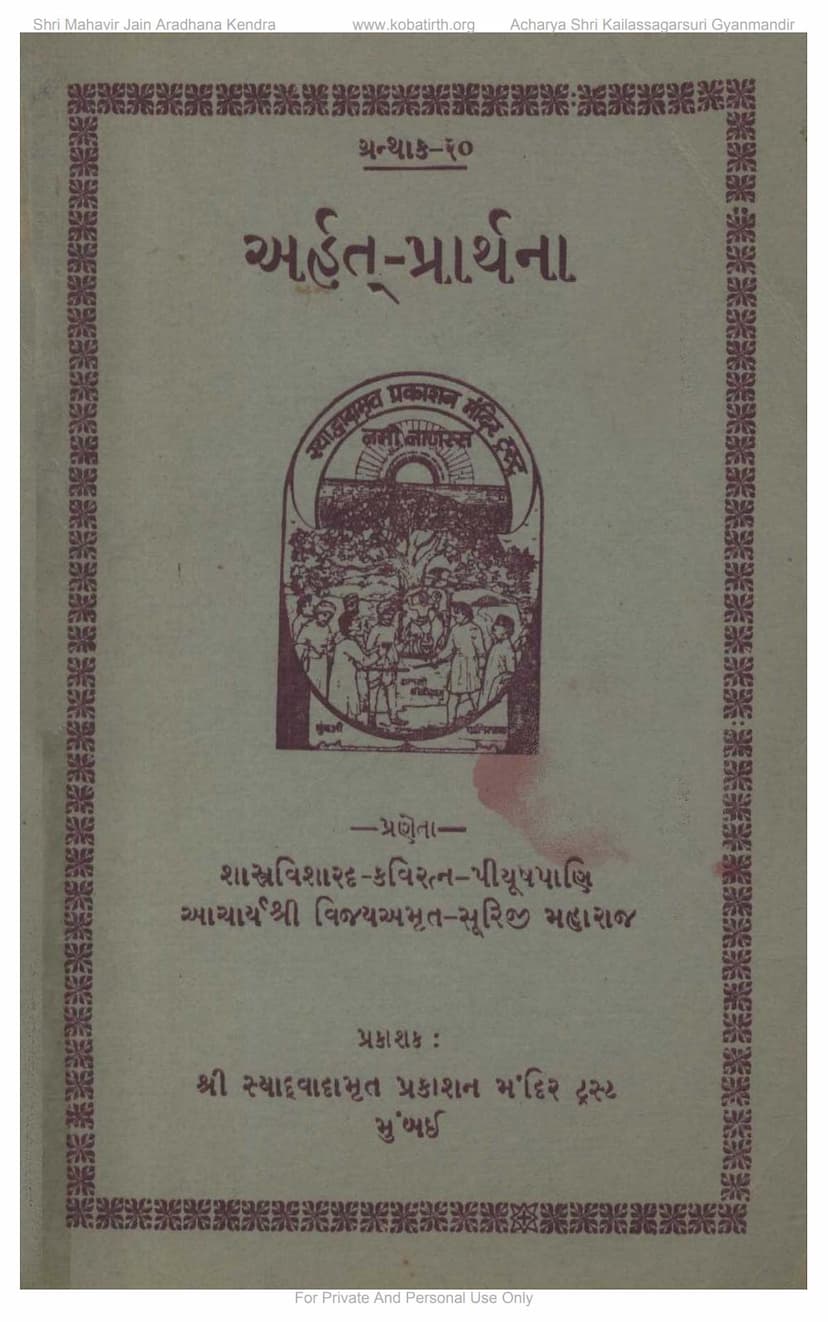Arhat Prarthana
Added to library: September 1, 2025

Summary
This document is a Jain text titled "Arhat Prarthana" (Prayer to the Arhats), authored by Acharya Shri Vijayamrutsuri. It was published by Shri Syadvadamrut Prakashan Mandir Trust, Mumbai. The text is presented as a collection of prayers, hymns, and spiritual reflections aimed at fostering devotion and spiritual growth within the Jain tradition.
Here's a breakdown of the key components and themes:
Overall Purpose:
The book is designed to be a devotional guide for Jains, offering prayers to the Tirthankaras (Arhats) and providing insights into righteous living. It emphasizes the importance of devotion, self-reflection, and adherence to Jain principles.
Key Sections and Content:
-
"Arhat Prarthana" (Prayer to the Arhats): This is the central theme of the book, as indicated by the title. The text includes a series of prayers addressed to the omniscient and liberated souls (Arhats/Tirthankaras). These prayers express the devotee's aspirations, struggles, and desires for spiritual progress.
-
"Chaturvishatika-Stuti" (Praise of the Twenty-Four Tirthankaras): The book contains a section that praises the twenty-four Tirthankaras, who are seen as beacons of spiritual guidance. These praises likely highlight the unique qualities and teachings of each Tirthankara.
-
"Atmanindatrivinsika by King Kumarpal" (Self-Reproach of King Kumarpal): A significant portion of the book is dedicated to the translation and commentary of a work by King Kumarpal, a historically significant Jain king. This section, the "Atmanindatrivinsika," is described as a "self-reproach" or "self-criticism."
- The Narrative of King Kumarpal: The introduction explains King Kumarpal's intellectual curiosity, even at an advanced age. It recounts an anecdote where a scholar compared a king to a cloud, highlighting the king's importance for sustenance. Kumarpal, dissatisfied with the analogy and seeking deeper knowledge, took up Sanskrit studies under Acharya Hemchandrasuri. This led him to compose the "Atmanindatrivinsika."
- Themes of Self-Reproach: The prayers attributed to Kumarpal in this section likely express deep remorse for past actions, acknowledge personal shortcomings, and reflect on the transient nature of worldly life. They are presented as heartfelt pleas for divine guidance and liberation.
- Translation and Commentary: The book provides both a Sanskrit original and a Gujarati translation and commentary (bhavarth) for these verses, making them accessible to a wider audience.
-
"Kalyankari Vicharana" (Auspicious Reflections): The book also includes "auspicious reflections" or contemplations that explain the path of spiritual development. These are meant to guide the reader towards self-improvement and understanding of Jain philosophy.
-
Devotional Songs and Dohe: Interspersed throughout the text are devotional songs (bhajans) and couplets (dohe) that are meant to be recited during prayers and worship. These are characterized by their simple yet profound language, aiming to evoke strong devotional feelings. Examples include:
- Prayers for divine vision: Expressing the longing to see the Tirthankaras.
- Confessions of spiritual struggles: Acknowledging the difficulty in overcoming desires, anger, and attachment, and seeking divine help.
- Praise of Tirthankara attributes: Highlighting their purity, compassion, and omnipotence.
- Requests for salvation: The ultimate goal of these prayers is liberation (moksha) from the cycle of birth and death.
-
Ritualistic Prayers: The text includes specific prayers to be recited during the eight types of worship (Ashtaprakari Puja) and during circumambulations (Pradakshina). These are practical guides for devotional practices.
-
"Kalyankari Bhavna" (Auspicious Contemplations): The later pages contain verses that pose questions about achieving spiritual milestones, such as seeing the Tirthankaras, practicing equanimity, undertaking austerities, and attaining omniscience. These are essentially aspirational prayers for spiritual attainment.
-
"Bhav Bhramam Nivaranya" (Prevention of Worldly Wandering): This section provides couplets to be recited during the three circumambulations around a sacred space, reinforcing the purpose of these rituals – to overcome the cycle of rebirth.
-
Praise of Specific Tirthankaras: The later part of the book provides praise verses for individual Tirthankaras (Rishabhdev, Ajitnath, Sambhavnath, etc.) in a specific meter (Mandakranta).
-
Praise of Siddhgiri and Chintamani Parshwanath: The book concludes with specific praises for the holy site of Siddhgiri and for the deity Chintamani Parshwanath.
-
Final Prayer: A concluding prayer asks for the continuous service of the Tirthankara's feet, rather than worldly possessions.
Key Themes:
- Devotion (Bhakti): The core of the text is an expression of deep devotion to the Arhats.
- Renunciation (Vairagya): The importance of detachment from worldly possessions and pleasures is emphasized, particularly through King Kumarpal's self-reproach.
- Spiritual Practice (Sadhana): The book offers guidance on devotional practices like puja and meditation.
- Self-Reflection and Correction: The "Atmanindatrivinsika" highlights the need for introspection and acknowledging one's faults to achieve spiritual progress.
- Aspiration for Liberation (Moksha): The ultimate goal of the prayers is to attain salvation from the cycle of birth and death.
- The Power of the Tirthankaras: The text venerates the Tirthankaras as the sole means to overcome suffering and achieve liberation.
In essence, "Arhat Prarthana" is a comprehensive devotional manual, offering a rich tapestry of prayers, hymns, and teachings aimed at guiding the Jain practitioner on the path to spiritual enlightenment and ultimate liberation.